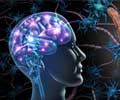A mutated gene acts on the nervous system to create the devastation of Huntington's disease
A mutated gene acts on the nervous system to create the devastation of Huntington's disease, according to researchers at the University of Illinois at Chicago College of Medicine. The report of their findings is available in Nature Neuroscience online.
The researchers were able to show that the mutated huntingtin gene activates a particular enzyme, called JNK3, which is expressed only in neurons and, further, to show what effect activation of that enzyme has on neuron function.Huntington's disease is an adult onset neurodegenerative disease marked by progressive mental and physical deterioration. It has been known for more than a decade that everyone who develops the disease has mutations in a particular gene, called huntingtin, according to Scott Brady, professor and head of anatomy and cell biology at the UIC College of Medicine.
"There are several puzzling aspects of this disease," said Brady, who is co-principal investigator on the study. "First, the mutation is there from day one. How is it that people are born with a perfectly functioning nervous system, despite the mutation, but as they grow up into their 30s and 40s they start to develop these debilitating symptoms? We need to understand why the protein is bad at 40 but it wasn't bad at 4."
The second problem, according to Brady, is that the gene is expressed not just in the nervous system but in other parts of the body. However, the only part of the body that is affected is the nervous system. Why are neurons being affected?
Brady, Gerardo Morfini, assistant professor of anatomy and cell biology at UIC and co-principal investigator of the study, and their colleagues began looking for a mechanism that could explain all the pieces of the puzzle. They found that at extremely low concentrations, huntingtin was a potent inhibitor of axonal transport, the system within the neuron that shuttles proteins from the cell body where they are synthesized to the synaptic terminals where they are needed.
A neuron's critical role in making connections may require it to make the cellular trunk, called an axon, between the cell body and the synaptic terminal to be very long. Some cells have axons that reach half the body's length -- for a tall person, a meter or more. But even in the brain, axonal projections are very long compared to other cells. In addition to the challenge of distance, neurons are very complex cells with many specialized areas necessary to carry out synaptic connections, requiring a robust transport system.
Advertisement
This mechanism also explains the late onset of the disease, Brady said. Activation of JNK3 reduces transport but does not eliminate it. Young neurons have a robust transport system, but transport gradually declines with age.
Advertisement
Brady's group has also linked this pattern of progressive neurodegeneration -- marked by a loss of signaling between neurons, a slow dying back of neurons, and eventual neuron death -- to damage to the transport system in several other hereditary adult-onset neurodegenerative diseases and to Alzheimer's disease.
"There is a common theme and a common Achilles heel of the neuron that underlies all these diseases," Brady said. "We've invented a word, dysferopathy, (from the Greek 'fero', to carry or transport) for these adult-onset neurodegenerative diseases. All have disruption of the axonal transport system in common."
Source-Eurekalert
RAS










